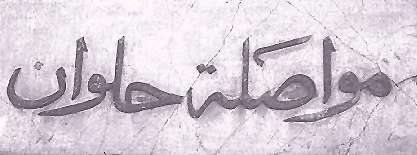
|
|
|
|
|
Cheers to our "talented" literature prize awardee. Your pain his gain !!!
|
|
|
EGY.COM - LANDMARKS - CAIRO - HELIOPOLIS
|
|
|
|
|
Cairo Times, 1 April 1999 |

You probably thought to yourself it was a shack for the homeless or, maybe, an old port-a-cabin left behind by some transient military unit which couldn't be bothered to take it along. Wrong both times. What you see to your left, below the Tonsi flyover, as you drive along the autostrada towards Maadi, passed the Citadel, is the derelict remains of Mowaslet Helwan (Helwan Junction), the nation's capital first ever suburban railway station.
Which is why surrounding the quaint wooden shed are all these old railway tracks, some more contorted than others. Look again. Further on you may still find an old signal kiosk and what used to be a water tower for steam locomotives.
What you have here is the first station travelers encountered late last century while en route to Helwan. Inaugurated by Khedive Ismail on 21 January 1877, the new state-owned Cairo-Helwan line was Cairo's first mechanized rail transit system. Then situated on Cairo's desert fringe under the shadow of the Mokatam Hills and the cavernous headquarters of the Suffi Biktashi sect, Helwan Junction was an significant rail connection for it was from there that a new set of tracks were laid in March 1890 branching westwards to the limestone quarries of Ein Sira (near today's Crazy House disco).
Four years later, in 1894, an auxiliary line was extended to the township of Sayeda Zeinab. Another set of tracks departed from Mowaslet Helwan for the quarries of Bassatine and Wadi Digla. The fourth and most important track however sped southwards through the desert towards Torah where Khedive Ismail had installed a fetishkhana--gunpowder factory, not far from the Spanish-run artillery academy created by his grandfather Mohammed Ali.
From Torah, the line continued to Helwan-les-Bains, a thriving fin de siècle thermal town created in 1874. Situated on an elevated desert plateau, Ismail's winter resort was frequented by the international café society (last century's equivalent of today's "jet set") which included much of Europe's fading aristocracy. In more ways then one, Helwan-les-Bains was not unlike today's fin de 20ieme siècle nearby settlement of Katameya. Built by a private concession, Helwan boasted handsome homesteads surrounded by lush gardens. Not far from town center was Egypt's first ever desert golf course.
Going in the other direction from Mowaslet Helwan were two separate sets of tracks. Both traveled northwards, one contouring the Citadel before it sped off to Abassia and Bab al-Hadid (now Ramses station). Because of the Mokatam Hills, a tunnel had to be dug out of the rock, a feat carried out by the Italian contracting firm of Gusman & Dentamaro.
The other northbound track only traveled a short distance ending at al-Midan a.k.a. Midan Salah al-Din or Midan Mohammed Ali. Situated at the foot of the Citadel, the Midan was where commuters linked up with horse-drawn omnibuses operated by the Suares Brothers. These were ultimately replaced by a modern tramway system in the last decade of the 19th century.
It was in November 1889 that Mowaslet Helwan lost its strategic value when the Suares Brothers decided to inaugurated the new Cairo-Helwan railway line departing from Bab al-Louk. Henceforth, the desert line from al-Midan to Torah was relegated to military purposes. And yet, on Feast days and High Holidays, as though by magic, Mowaslet Helwan would come alive as passengers commuted by special railway car to the cemeteries of Imam al-Shafei, Bab al-Wazir and the ancient Rabbinical Cemetery of Bassatine.
During the WW2 Mowaslet Helwan regained some importance when thousands of Allied troops landed from Australia, New Zealand and South Africa via Suez. From the Red Sea they traveled by rail to large makeshift army bases outside Helwan and Maadi. Seventy six thousand Kiwis from New Zealand passed through Mowaslet Helwan between 1939-45.
As Helwan became a gianormous industrial zone in Nasser's '60s, surrounded by belching smokestacks and large factories, the thermal spa that was lost the little which remained of its healing capacities. This had become the place to go if you wanted to catch a lung disease. Conversely, the original Cairo-Helwan line was revived once more this time as a freight line. One century to the year separated it from the aristocracy that had traveled to Helwan in its quaint wooden wagons.
As Cairo continues to expand in all directions, the quarry tracks were the first to disappear. Gradually, the secondary tracks perished with the exception of the rickety Digla-Torah line. Today, all that remains of the city's first suburban railway station is the shed for the homeless, a sorry sight if there was ever one.
|
|
|
|